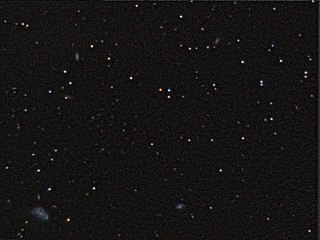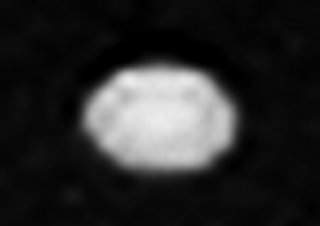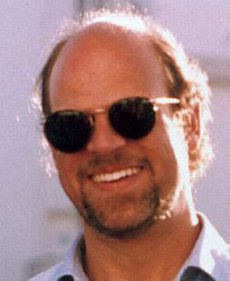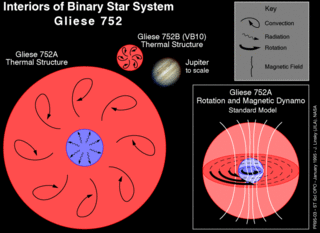Related Research Articles
The REsearch Consortium On Nearby Stars (RECONS) is an international group of astronomers founded in 1994 to investigate the stars nearest to the Solar System - with a focus on those within 10 parsecs, but as of 2012 the horizon was stretched to 25 parsecs. In part the project hopes a more accurate survey of local star systems will give a better picture of the star systems in the Galaxy as a whole.

Wolf 359 is a red dwarf star located in the constellation Leo, near the ecliptic. At a distance of approximately 7.9 light years from Earth, it has an apparent magnitude of 13.54 and can only be seen with a large telescope. Wolf 359 is one of the nearest stars to the Sun; only the Alpha Centauri system, Barnard's Star, and the brown dwarfs Luhman 16 and WISE 0855−0714 are known to be closer. Its proximity to Earth has led to its mention in several works of fiction.

Steven Jeffrey Ostro was an American scientist specializing in radar astronomy. He worked at NASA's Jet Propulsion Laboratory. Ostro led radar observations of numerous asteroids, as well as the moons of Jupiter and Saturn, Saturn's rings, and Mars and its satellites. As of May 2008, Ostro and his collaborators had detected 222 near-Earth asteroids and 118 main belt objects with radar.

Despina, also known as Neptune V, is the third-closest inner moon of Neptune. It is named after Greek mythological character Despoina, a nymph who was a daughter of Poseidon and Demeter.
Jack Wisdom is a Professor of Planetary Sciences at the Massachusetts Institute of Technology. He received his B.S. from Rice University in 1976 and his Ph.D. from California Institute of Technology in 1981. His research interests are the dynamics of the Solar System.
The Palomar Planet-Crossing Asteroid Survey (PCAS) was an astronomical survey, initiated by American astronomers Eleanor Helin and Eugene Shoemaker at the U.S Palomar Observatory, California, in 1973. The program is responsible for the discovery of 95 near-Earth Objects including 17 comets, while the Minor Planet Center directly credits PCAS with the discovery of 20 numbered minor planets during 1993–1994. PCAS ran for nearly 25 years until June 1995. It had an international extension, INAS, and was the immediate predecessor of the outstandingly successful NEAT program.

Robert Paul Butler is an astronomer and staff scientist at the Carnegie Institution for Science in Washington, D.C., who searches for extrasolar planets.
HD 82943 is a yellow dwarf star approximately 89 light-years away in the constellation of Hydra. Two extrasolar planets have been confirmed to be orbiting it, and it is thought that the system had more giant planets that were "swallowed" by the parent star. HD 82943 is estimated at 1.15 times the mass of the Sun.
LP 145-141 is an isolated white dwarf located 15 light years from the Solar System. According to a 2009 paper, it is the fourth closest known white dwarf to the Sun
Joseph Burns is a professor at Cornell University with a dual appointment in the Sibley School of Mechanical and Aerospace Engineering (MAE) and the Astronomy department. His primary area of research is dynamics in planetary sciences.

Gliese 752 is a binary star system in the Aquila constellation. This system is relatively nearby, at a distance of about 19 light years.
George David Gatewood also known as George G. Gatewood, is an American astronomer and presently is professor emeritus at the University of Pittsburgh and at the Allegheny Observatory. He specializes in astronomy, astronomical instrumentation, statistical methods, stellar astrophysics, astrometric properties of nearby stars and the observational discovery and the study of planetary systems. He came to popular attention with his 1996 announcement of the discovery of a nearby multi-planet star system. This discovery has yet to be confirmed and is regarded with skepticism today.
HD 96700 is the Henry Draper Catalogue designation for a star in the equatorial constellation of Hydra. It has an apparent visual magnitude of 6.51, which puts it below the limit that can be seen with the naked eye by a typical observer. Based upon parallax measurements, this star is around 83 light years away from the Sun. It is drifting further away with a radial velocity of 12.8 km/s.
HD 191806 is a star located in the northern constellation Cygnus. With an apparent magnitude of 8.093, it's undetectable with the naked eye, but can be seen with binoculars. HD 191806 is currently placed at a distance of 215 light years based on parallax measurements and is drifting towards the Solar System with a spectroscopic radial velocity of −15.28 km/s.

Henry B. Throop, is an American astronomer and planetary scientist who specializes in the dynamics of rings and dust in the outer solar system. Throop is a member of the science team for NASA's New Horizons mission to Pluto and the Kuiper Belt, and has been involved with NASA missions throughout the solar system. Throop lives in Washington, DC where he runs NASA's science programs in the outer solar system. He has done extensive education and outreach around the world, having spent nearly a decade as an astronomer living in South Africa, India, and Mexico. The asteroid 193736 Henrythroop is named after him.
9 Puppis is a binary star system in the southern constellation of Puppis. It was originally designated 9 Argus, being part of the now defunct Argo Navis constellation. The system is faintly visible to the naked eye as a point of light with a combined apparent visual magnitude of 5.16. The magnitude difference between the two stars is 0.65. Parallax measurements yield a distance estimate to 9 Puppis of approximately 54 light years from the Sun, with the dynamic and trigonometric parallaxes for the system being in close agreement. It is drifting closer with a systemic radial velocity of –21 km/s. The motion of the system through space is predicted to bring it as close as 42.2 light-years in about 292,000 years.
References
- ↑ Thompson, W. R.; Henry, T. J.; Schwartz, J. M.; Khare, B. N.; Sagan, C. (March 1991). "Plasma discharge in N2 + CH4 at low pressures - Experimental results and applications to Titan". Icarus. 90 (1): 57–73. Bibcode:1991Icar...90...57T. doi: 10.1016/0019-1035(91)90068-5 . ISSN 0019-1035. PMID 11538099.
- ↑ Henry, Todd Jackson (1991). A systematic search for low-mass companions orbiting nearby stars and the calibration of the end of the stellar main sequence (PhD Thesis). Arizona University, Tucson. Bibcode:1991PhDT........11H.
- ↑ Henry, Todd J.; Kirkpatrick, J. Davy; Simons, Douglas A. (October 1994). "The solar neighborhood, 1: Standard spectral types (K5-M8) for northern dwarfs within eight parsecs". The Astronomical Journal . 108 (4): 1437–1444. Bibcode:1994AJ....108.1437H. doi:10.1086/117167.
- ↑ Bean, Jacob L.; Seifahrt, Andreas; Hartman, Henrik; Nilsson, Hampus; Reiners, Ansgar; Dreizler, Stefan; et al. (2009). "The CRIRES Search for Planets Around the Lowest-Mass Stars. II. No Giant Planet Orbiting VB10". arXiv: 0912.0003v1 [astro-ph.EP].
- ↑ "AAS Fellows". AAS. Retrieved 28 September 2020.